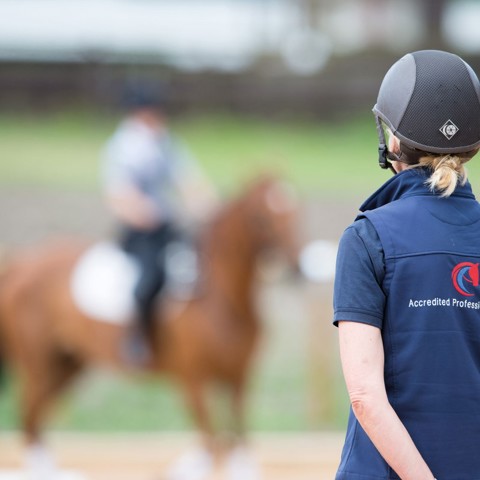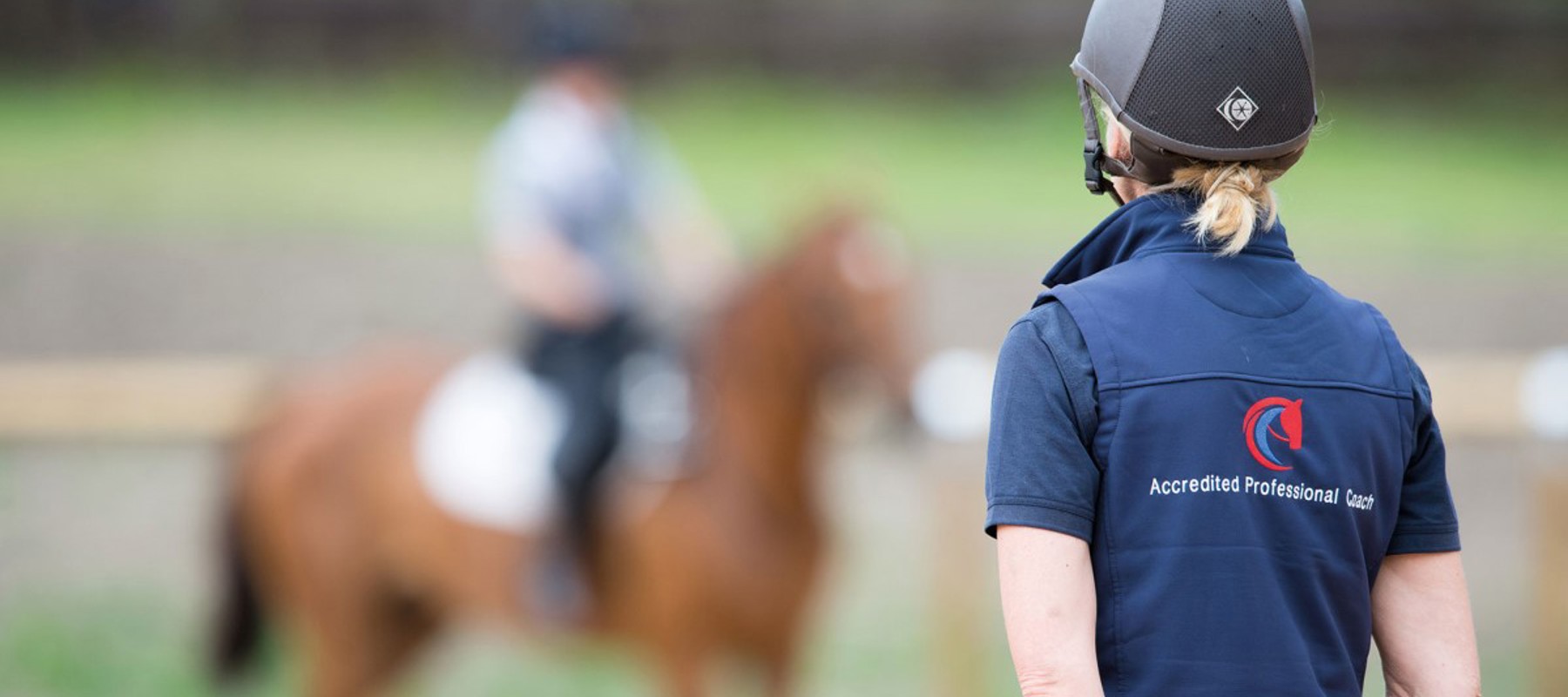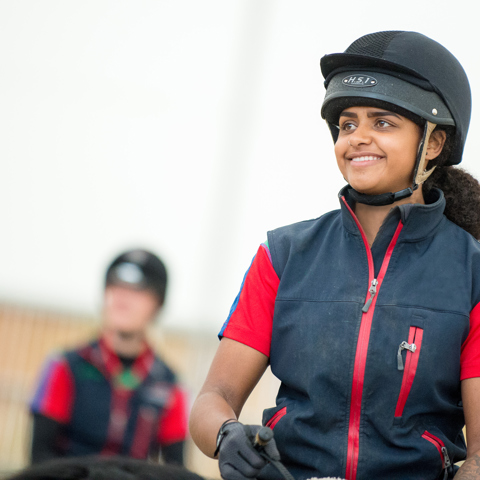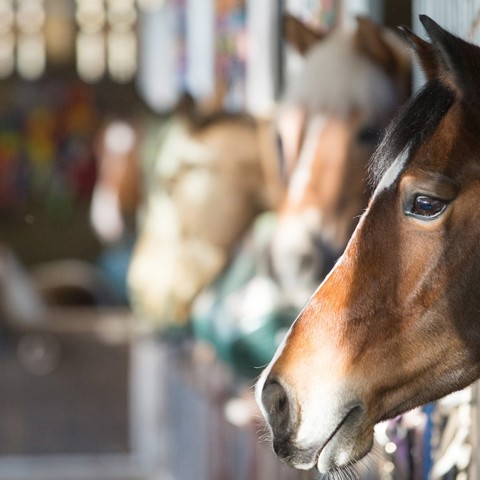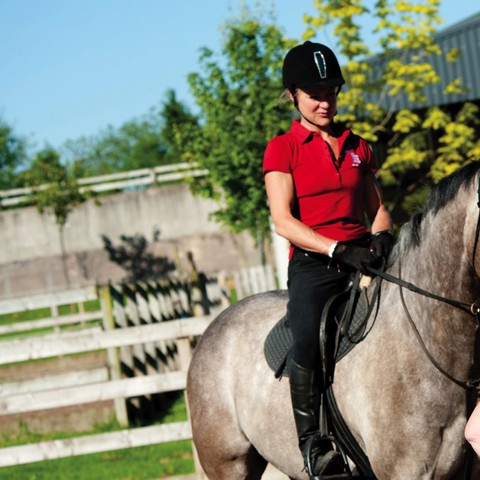Within this section you will be assessed in the following areas:
Download the assessment criteria.
1. Assess a rider
chevron-down
chevron-up
In this section you will observe a horse and rider combination. The rider will be working the horse, but you will not be coaching the rider. You will make a verbal assessment of the rider, their skills and the influence they have over the horse’s way of going. This will include work on the flat only.
The horse or pony and rider will be any level of ability and could be an established partnership or a trainee on a school horse. The horse can be any size, type and breed and the horse, pony or rider can be capable of varying quality of work. It will be a partnership you have not coached before, but you may go on to coach them for later sessions in the assessment.
This may take place in an enclosed area and the horse and rider may share the area with other riders.
The assessment for this section will follow immediately after one of your coaching sessions and should last approximately 10 minutes. You will then discuss your observations with the assessor.
2. Semi-private polework session
chevron-down
chevron-up
You will coach two horse and rider combinations for a semi-private lesson in this flatwork with poles session. There will be a pre-prepared area with poles. You can use up to 12 poles and you will set up and move the poles as required.
Each rider will be of a different skill level and you will be expected to adapt your session to accommodate each rider’s ability. One rider will be at Stage 3 working towards Stage 4 and one rider will be at Stage 4 working towards Performance level. The riders will be career students working towards BHS qualifications; you should be able to advise the riders on their performance in relation to the BHS qualifications and the BHS career pathways structure.
You will assess each rider in the warm up and ask any relevant questions. You will then coach the riders to develop their skills and knowledge and ability to influence their horse. The exercises you choose may be the same or different for each rider, but they must suit the different ability of each rider and the level they are working towards.
You can bring technology with you to assist your coaching (for example a headset and earpiece), but this is not compulsory. You must provide your own technology equipment should you wish to use it.
The assessment for this section should last approximately 60 minutes. 10 minutes to set up your pole exercises, your coaching session should last 35-40 minutes, and an additional 10 minutes allowed for discussion with the assessor.
3. Show jumping competition session (up to 1.15m)
chevron-down
chevron-up
You will coach one horse and rider combination in this session. The partnership will be capable of jumping a 1.10m-1.15m course. The quality of work may vary. It can be an established competitive horse and rider combination or a career student riding a school horse. The horse or rider may have none, limited or significant competition experience. The rider may wish to progress their riding up the levels or want to improve at existing level. The horse may be of any level of fitness.
You will have sole or shared use of an enclosed arena or grass. There will be a pre-prepared jumping area with a course or approximately six to eight fences. The fences will be a mixture of uprights, spreads, oxers and combinations. You will first warm the horse and rider up over a few fences. They then dismount and you will walk the course with the rider and talk through the fences and lines.
You will structure your session to develop the horse and rider combination with the course in mind. The exercises should aim to improve the work observed and horse and rider performance.
This session will last approximately 60 minutes. 10 minutes for a warm up, 5-10 minutes for a course walk, your coaching session should last 30 minutes, and an additional 10 minutes allowed for discussion with the assessor.
4. Show jumping session (up to 1.20m)
chevron-down
chevron-up
You will coach one horse and rider combination in this session. The partnership will be capable of jumping up to a 1.20m course. The quality of work may vary. It can be an established competitive horse and rider combination or a career student riding a school horse. The horse or rider may have none, limited or significant competition experience. The rider may wish to progress their jumping or want to improve at existing level. The horse may be of any level of fitness.
You will have sole or shared use of an enclosed arena or grass. There will be a pre-prepared jumping area of approximately six to eight fences. The fences will not be numbered but will allow for linking of two or more fences in a competitive context. The fences will be a mixture of uprights, spreads, oxers and combinations. You will be expected to familiarise yourself with the show jumping arena before your assessment begins. This time is not factored into the timetable of the day, so please ensure you arrive in time to do this before your assessment briefing.
You will assess your horse and rider and ask any relevant questions at the beginning of the session. From your assessment you should have a clear structure, plan and goal. You may choose any exercises providing the rider has a clear understanding of it and it is within the horse and rider’s capabilities.
This session will last approximately 60 minutes; your coaching session should last 35-40 minutes, and an additional 10 minutes allowed for discussion with the assessor.
5. Coaching presentation
chevron-down
chevron-up
This section will enable you to showcase your experience of training and developing rider and horse combinations in an area or discipline and evaluate your coaching. A Performance Coach will regularly reflect on their coaching practice and methodologies to find ways to enhance and develop their craft.
You will present your general experience coaching riders and training horses, and then focus the presentation on your experience coaching a specific rider over a minimum period of six months. Your chosen rider can either be a rider and horse combination working towards competition or a career student rider training on multiple horses. The focus should not be on the development of the horse, but instead the development of the rider’s skills, confidence and influence on the horse, although the horse’s improvement and development can be discussed. You should also discuss your coaching philosophy and how you adapt your coaching to meet the rider’s needs. The assessor would be keen to understand your self-reflection process to ensure you continue to meet the rider’s needs.
For this assessment you will present to a BHS Assessor.
Your presentation should last between 15-30 minutes. You can bring resources/ supporting evidence such as a logbook, photos or videos (on your own device) as evidence to support your discussion.
Following your presentation, the assessor will have an opportunity to ask questions.
The assessment for this section should last approximately 45 minutes and is assessed as a standalone assessment.
Please note there is an exemption for this assessment for anyone who has passed their UKCC Level 4 assessment, evidence will need to be provided to the BHS Education Team.
Entry requirements
chevron-down
chevron-up
- A minimum age of 18 years
- Stage 4 Senior Coaching Eventing (Unit 7), or Stage 4 Senior Coaching Show Jumping (Unit 9), or BHS/BHSQ equivalent
- BHS Gold membership – Membership discounts apply for learners who are training for or taking BHS qualifications
- International students should be either International Full or International E-Members.

